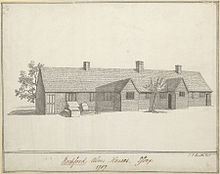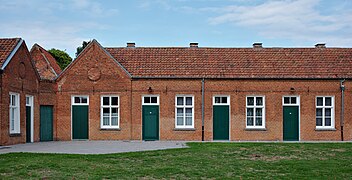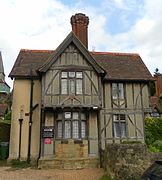
Dorothea Lynde Dix was an American advocate on behalf of the indigent mentally ill who, through a vigorous and sustained program of lobbying state legislatures and the United States Congress, created the first generation of American mental asylums. During the Civil War, she served as a Superintendent of Army Nurses.

Tewksbury Hospital is a National Register of Historic Places-listed site located on an 800+ acre campus in Tewksbury, Massachusetts. The centerpiece of the hospital campus is the 1894 Richard Morris Building.
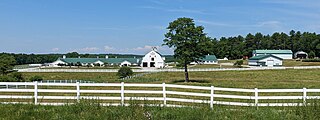
Pineland Farms is a 5,000-acre farm and recreational property in the eastern part of New Gloucester, Maine. It is partly on the site of the former Pineland Hospital and Training Center.

Harrisburg State Hospital, formerly known from 1851 to 1937 as Pennsylvania State Lunatic Hospital, in Harrisburg, Pennsylvania, was Pennsylvania's first public facility to house the mentally ill and disabled. Its campus is located on Cameron and Maclay Streets, and operated as a mental hospital until 2006.

The Blockley Almshouse, later known as Philadelphia General Hospital, was a charity hospital and poorhouse located in West Philadelphia. It originally opened in 1732/33 in a different part of the city as the Philadelphia Almshouse. Philadelphia General Hospital closed in 1977.
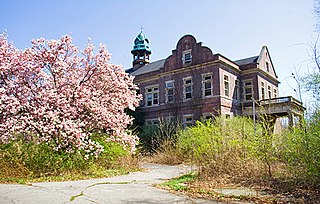
Pennhurst State School and Hospital, originally known as the Eastern Pennsylvania State Institution for the Feeble-Minded and Epileptic was a state-run institution for mentally and physically disabled individuals of Southeastern Pennsylvania located in Spring City. After 79 years of controversy, it closed on December 9, 1987.

The Rosewood Center was an institution for people with developmental disabilities located on Rosewood Lane in Owings Mills, Maryland.

The Fairview Training Center was a state-run facility for people with developmental disabilities in Salem, Oregon, United States. Fairview was established in 1907 as the State Institution for the Feeble-Minded. The hospital opened on December 1, 1908, with 39 patients transferred from the Oregon State Hospital for the Insane. Before its closure in 2000, Fairview was administered by the Oregon Department of Human Services (DHS). DHS continued to operate the Eastern Oregon State Hospital in Pendleton until October 31, 2009.

Sexey's Hospital in Bruton, Somerset, England was built around 1630 as almshouses. The West Wing and chapel have been designated as a Grade I listed building. The East Wing and gateway are grade II listed.
The Jacksonville Developmental Center was an institution for developmentally delayed clients, located in Jacksonville, Illinois. It was open from 1851 to November 2012. As of December 2012, the 134-acre (54 ha) grounds was still owned by the State of Illinois.

Letchworth Village was a residential institution located in Rockland County, New York, in the hamlet of Thiells built for the physically and mentally disabled of all ages, from the newborn to the elderly. Opened in 1911, Letchworth Village at its peak consisted of over 130 buildings spread out over many acres of land. It was named for William Pryor Letchworth, who espoused reform in the treatment and care of the insane, epileptics, and poor children.

The Virginia State Colony for the Epileptics and Feeble Minded was a state run institution for those considered to be “Feeble minded” or those with severe mental impairment. The colony opened in 1910 near Lynchburg, Virginia, in Madison Heights with the goal of isolating those with mental disabilities and other qualities deemed unfit for reproduction away from society. The colony was the home of Carrie Buck, the subject of the landmark Supreme Court case Buck v. Bell.
Rufus Wyman (1778–1842) was an American physician. He was the first physician and superintendent of the Asylum for the Insane, renamed in 1823 to McLean Hospital, part of the Massachusetts General Hospital system, and the first mental hospital in the state.

Mary Dendy was a promoter of residential schools for mentally handicapped people, i.e. institutionalisation. Dendy was the driving force that established a colony for the "feeble-minded". Dendy believed in separate development to avoid crime and these people passing their problems on to their children. She joined the Eugenics Education Society.
John B. Chapin M.D. (1829-1918) was an American physician and mental hospital administrator. He was an advocate for the removal of mentally ill patients from the almshouses in New York State to a hospital setting and helped to pass a state law that provided hospital care for the patients.

Richard Watts Charities incorporate Richard Watts Charity set up in the will of Richard Watts in 1579, as well as several other charities in Rochester, Medway. The will originally provided for an almshouse in Rochester High Street: The Poor Travellers House; over time, the money later provided for almshouses in Maidstone Road, along with other accommodation in Rochester, totalling 66 self-contained flats. Other charities absorbed by the Richard Watts Charity include St Catherine's Hospital founded under the Charity of Symond Potyn in 1315.
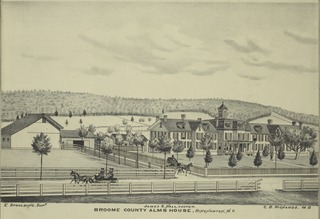
The Broome County Alms House, was located in the town of Dickinson, three miles north of Binghamton in Broome county, New York. The red brick building operated as a shelter for the poor, take care of the sick, disabled, mentally unwell, widowed, and orphaned persons in the community until c. 1960. The goal of the almshouse was to both help break the cycle of poverty and to care for members of the community who had no means of caring take of themselves. The building was demolished on February 5, 2010.
William D. Partlow Developmental Center, also known as the Partlow State School and Hospital, was a state school for people with mental disabilities, primarily intellectual and developmental disabilities in Tuscaloosa, Alabama, USA. It was operated by the Alabama Department of Mental Health. It was the last such full-sized facility operated by the State of Alabama and closed in 2011.
State schools are a type of institution for people with intellectual and developmental disabilities in the United States. These institutions are run by individual states. These state schools were and are famous for abuse and neglect. In many states, the residents were involuntary sterilized during the eugenics era. Many states have closed state schools as part of the deinstitutionalisation movement.
